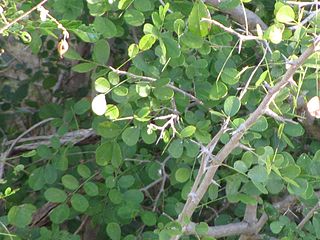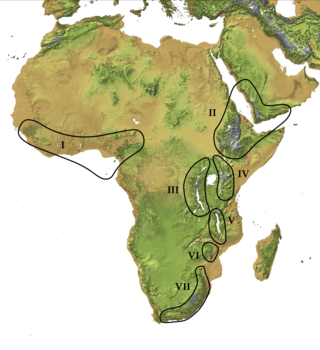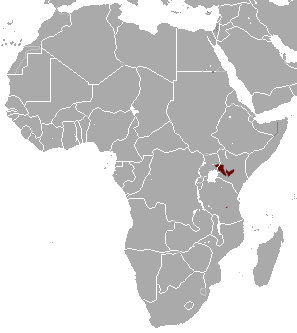
Dalbergia melanoxylon is a flowering plant in the family Fabaceae, native to seasonally dry regions of Africa from Senegal east to Eritrea and south to the north-eastern parts of South Africa. The tree is an important timber species in its native areas; it is used in the manufacture of musical instruments and fine furniture. Populations and genomic resources for genetic biodiversity maintenance in parts of its native range are threatened by overharvesting due to poor or absent conservation planning and by the species' low germination rates.

The Afromontane regions are subregions of the Afrotropical realm, one of the Earth's eight biogeographic realms, covering the plant and animal species found in the mountains of Africa and the southern Arabian Peninsula. The Afromontane regions of Africa are discontinuous, separated from each other by lower-lying areas, and are sometimes referred to as the Afromontane archipelago, as their distribution is analogous to a series of sky islands.

The Amani Nature Reserve is a protected area located within the Muheza and Korogwe Districts in the Tanga Region of Tanzania, in tropical East Africa.

The pancake tortoise is a species of flat-shelled tortoise in the family Testudinidae. The species is native to Tanzania and Kenya. Its common name refers to the flat shape of its shell.

Jackson's mongoose is a mongoose species native to montane forests in Kenya, Uganda and Tanzania. It appears to be rare and has been classified as Near Threatened since 2008.
Julbernardia magnistipulata is a species of plant in the family Fabaceae. It is found in Kenya and Tanzania.

Krefft's warty frog, or Krefft's secret frog, is a species of frog in the family Brevicipitidae. It is found in the Eastern Arc Mountains in Tanzania and in southern Kenya. Its natural habitats are subtropical or tropical moist lowland forests, subtropical or tropical moist montane forests, rural gardens, and heavily degraded former forest. It is threatened by habitat loss.
Neohemsleya is a genus of plant in family Sapotaceae described as a genus in 1991.
Michelsonia is a genus of tree in the legume family, Fabaceae, where it is classified in the subfamily Detarioideae. It is a monotypic genus, the only species being Michelsonia microphylla. It is native to the tropical rain forests of the Democratic Republic of the Congo. The wood is used locally for construction work.

Nuxia floribunda, the forest elder, forest nuxia or wild elder, is a species of tree in the Stilbaceae family, that is native to moist regions of southern Africa, East Africa and central tropical Africa.

Rhipidoglossum is a genus of flowering plants from the orchid family, Orchidaceae. It contains about 20-30 species, all from sub-Saharan Africa.
Hylomyscus endorobae is a species of rodent of the genus Hylomyscus that is found only in select portions of the wet East African montane forests of the Kenyan Rift mountains of southwestern Kenya and Tanzania, and only at elevations above 2,000 metres (6,600 ft).

Northern Zanzibar–Inhambane coastal forest mosaic, also known as the Northern Swahili coastal forests and woodlands, is a tropical moist broadleaf forest ecoregion of coastal East Africa. The ecoregion includes a variety of habitats, including forest, savanna and swamps.

Strychnos usambarensis is a shrub or small tree up to 15m tall or a 70m long liane of Sub-Saharan Africa, occurring in forest and woodland, mountain ravines and coastal bush, often on rocky slopes and named for the Usambara Mountains of Tanzania. The species is found from Guinea east to Nigeria, from Congo east to Kenya and south to kloofs of the Magaliesberg of South Africa. Bantu tribes from Rwanda and Tanzania produce an arrow poison from the root bark and leaves of this species, sometimes combining it with extracts from other plants.

Vachellia robusta, the splendid thorn, is an Afrotropical tree species.
Callulina shengena is a species of frogs in the family Brevicipitidae. It was discovered in 2010 during a survey of rainforests in the northern part of the Eastern Arc Mountains of Tanzania. It is present at two locations in Chome Forest Reserve at altitudes between 1,920 and 2,100 m. The forests in which it lives are being selectively felled, and the International Union for Conservation of Nature has rated its conservation status as "critically endangered".
Erica trimera is a species of flowering plant. It is a shrub or tree which grows in the mountains of eastern and central Africa.
Cornus volkensii is a species of tree in the family Cornaceae native to montane forests of eastern Africa, from South Sudan and Kenya south to Zimbabwe and Mozambique.
Gambeya gorungosana is species of evergreen tree native to eastern and central Africa.












